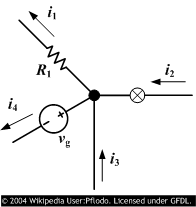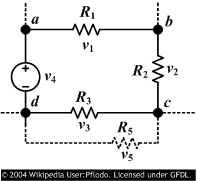Kirchhoffin piirilait
Kirchoffin piirilait kertovat sähkövarauksen ja energian säilymisestä virtapiireissä.
Molemmat piirilait voidaan johtaa Maxwellin yhtälöistä, mutta Kirchoff edelsi ajallisesti Maxwellia ja laajensi Ohmin töitä.
(http://en.wikipedia.org/wiki/Kirchhoff%27s_circuit_laws)
Kirchhoffin virtalaki
Tämä laki tunnetaan myös nimillä: Kirchhoffin ensimmäinen laki, Kirchhoffin pistesääntö, Kirchhoffin liitossääntö ja Kirchhoffin ensimmäinen sääntö.
Sähkövarauksen säilyminen implikoi, että:
- Missä tahansa virtapiirin kohdassa jonka varaustiheys
ei muutu ajan suhteen, siihen pisteeseen saapuvien sähkövirtojen summa on yhtä suuri kuin siitä poistuvien sähkövirtojen summa.
Varaustiheyden ajallinen muutos merkitsisi nettovarauksen lisääntymistä tai vähenemistä, mitä yleensä ei voi tapahtua mitenkään merkittävässä määrin johtuen sähköstaattisten voimien suuruudesta. Varauksen kertymä aiheuttaisi poistovoimia jotka alentavat varaustiheyttä.
However, a charge buildup can occur in a capacitor, where the charge is typically spread over wide parallel plates, with a physical break in the circuit that prevents the positive and negative charge accumulations over the two plates from coming together and cancelling. In this case, the sum of the currents flowing into one plate of the capacitor is not zero, but rather is equal to the rate of charge accumulation. However, if the displacement current dD/dt is included, Kirchhoff's current law once again holds. (This is only required if one wants to apply the current law within the capacitor. In circuit analyses, however, the capacitor as a whole is typically treated as a unit, in which case the ordinary current law holds since the net charge is always zero.)
More technically, Kirchhoff's current law can be found by taking the divergence of Ampere's law with Maxwell's correction and combining with Gauss's law, yielding:
:
This is simply the charge conservation equation (in integral form, it says that the current flowing out of a closed surface is equal to the rate of loss of charge within the enclosed volume). Kirchhoff's current law is equivalent to the statement that the divergence of the current is zero, true for time-invariant ρ, or always true if the displacement current is included with J.
Kirchhoffin jännitelaki
Tämä laki tunnetaan myös nimillä: Kirchhoffin toinen laki, Kirchoffin silmukkasääntö ja Kirchhoff's second rule.
Energian häviämättömyyden periaatteesta seuraa:
- The directed sum of the electrical potential differences around a circuit must sum to zero.
(Otherwise, it would be possible to build a perpetual motion machine that passed a current in a circle around the circuit.)
This law has a subtlety in its interpretation, because in the presence of a changing magnetic field the electric field is not conservative and it cannot therefore define a pure scalar potential—the line integral of the electric field around the circuit is not zero. Equivalently, energy is being transferred from the magnetic field to the current (or vice versa). In order to "fix" Kirchhoff's voltage law for this case, an effective potential drop, or electromotive force (emf), is associated with the inductance of the circuit, exactly equal to the amount by which the line integral of the electric field is not zero by Faraday's law of induction.


